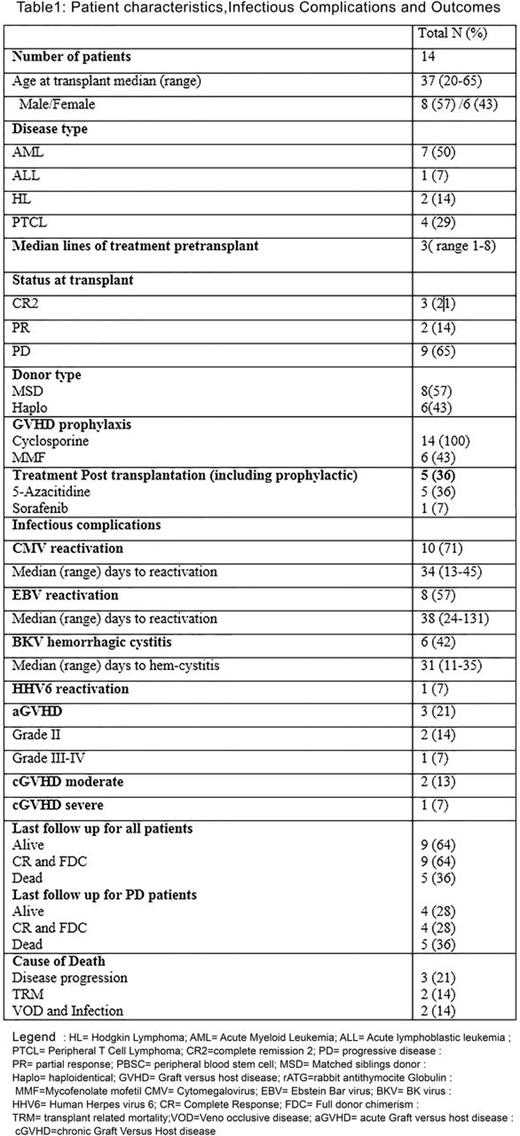Abstract
INTRODUCTION: Relapsed / Refractory leukemia and lymphoma (R/R, L/L) patients have a very poor prognosis despite all the well-known therapeutic strategies. Sequential conditioning followed by allogeneic stem cell transplantation (allo-SCT) provides an efficient disease control in those high risk patients.
PATIENTS AND METHODS: we conducted a retrospective study at the American University of Beirut medical center (AUBMC) to assess the safety and efficacy of sequential conditioning in patients with R/R, L/L undergoing allo-SCT. We included 14 consecutive patients with (R/R, L/L) who received sequential conditioning followed by allogeneic stem cell transplantation (allo-SCT) from either matched related or haploidentical donors from April 2015 to May 2017. At time of transplantation patients included in the study were either in progressive disease (PD) or complete remission 2 (CR2), or partial remission (PR) after many lines of treatment. The study was approved by the institutional review board of American University of Beirut Medical Center. All patients received the following conditioning regimen of sequential chemotherapy: Thiotepa intravenous (IV) (5mg/kg/day) on days -13 and -12, Cyclophosphamide IV (400mg/m2/day) from day -11 to day -8 , Etoposide IV (100mg/m2/day) from day -11 to day-8, Fludarabine IV (30mg/m2/day) from day -5 to day-1, Busulfan IV (130mg/m2/day) on days -5 and -4 and ATG (thymoglobuline) IV 2,5 mg/kg on days -2 and -1 , followed by peripheral stem cells infusion on day 0. All patients characteristics, infectious complications and outcomes are listed in Table1.The primary outcomes weresafety and efficacy of this new sequential conditioning in allo-SCT. Secondary outcomes included engraftment, chimerism, acute and chronic graft versus host disease (GVHD), infections and relapse on days +30, +100 and 1 year post allo-SCT.
RESULTS: After a median follow up of 7 months (range, 2-23) post-allo-SCT, all patients had neutrophil engraftment after a median time of 14 days (range, 10-20), and 13 patients had platelets engraftment after a median time of 15 days (range, 10-100). One patient failed to have platelets engraftment. At the time of last follow up, 9 patients (64%) were alive with complete remission (CR), with a median follow up of those of 7 months (range,2-23); four of whom had progressive disease (PD) at time of transplantation. Five patients who had PD at time of transplantation died. Of those, three (21%) died due to disease relapse that occurred at a median time of 152 days post allo-SCT (range, 60-296). The other two (14%) patients died because of transplant related mortality, one because of veno occlusive disease and one because of infection while were in CR. The cumulative incidence of Grade II-IV acute GVHD was 21%. Three patients (21%) developed chronic GVHD. The median progression free survival (PFS) and the median overall survival (OS) were not reached. All the complications and outcomes post allo-SCT are listed in table 1.
CONCLUSIONS: Our results indicate that this sequential conditioning regimen appears to be feasible, with low TRM, allows high rate of engraftment and good disease control among high-risk patients. Further large prospective trials needed to evaluate that.
No relevant conflicts of interest to declare.
Author notes
Asterisk with author names denotes non-ASH members.


This feature is available to Subscribers Only
Sign In or Create an Account Close Modal